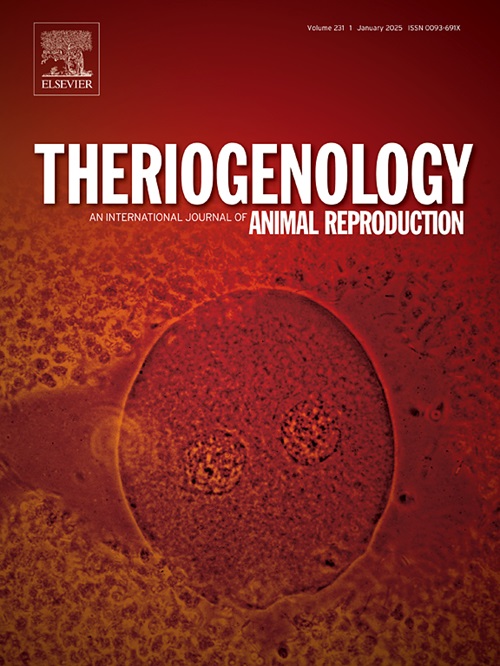体外成熟马卵母细胞卵浆内单精子注射(ICSI)后解冻后精子质量参数与囊胚产生的关系
IF 2.4
2区 农林科学
Q3 REPRODUCTIVE BIOLOGY
引用次数: 0
摘要
通过胞浆内单精子注射(ICSI)体外生产马胚胎通常用于最大限度地利用种马精子,特别是来自精液供应有限的种马。冷冻/解冻精液中精子质量的标准指标(即精子活力、正常形态、DNA质量)与体外成熟马卵母细胞ICSI后胚胎产生之间的关系尚未得到深入研究。在这项研究中,研究人员分析了47匹公马的冷冻/解冻精液,用于商业ICSI项目,分析了解冻后精子总活力和进展活力(主观和计算机辅助精子分析[CASA]测定)、形态学特征(差示干涉对比[DIC]显微镜)和DNA损伤(精子染色质结构测定- SCSA)。在游泳后选择形态正常的精子,并将其注射到来自58匹母马(85个周期)的485个体外成熟马卵母细胞中。精子质量特征(游泳前后)与卵裂(icsi后第5天的8个卵裂球)或囊胚发育(icsi后第7-10天)之间的关系采用反向逐步logistic回归分析。没有精子质量参数与卵裂相关(P >;0.05)。与囊胚产生相关的解冻后精子质量参数包括游泳前平均(±SD)总能动性(TMOT),主观测定(34±13%);优势比[OR]: 1.20, 95%可信区间[CI]: 1.02-1.42),或CASA(29±13%;Or: 1.08, ci: 1.01-1.28);游泳前形态正常的精子(57±11%);Or: 1.31, ci: 1.10-1.57)。相比之下,游泳前近端液滴平均(±SD)为(5±4%);OR: 0.63, CI: 0.41-0.94),卷尾(2±1%;OR: 0.25, CI: 0.08-0.63), COMPαt(16±8%;OR: 0.74, CI: 0.57-0.96)与囊胚产生呈负相关(P <;0.05)。解冻后TMOT(主观或通过CASA确定)和正常(游泳前)与囊胚产生可能性较高相关的阈值分别为44%和56%。除了这些精子质量参数外,注射卵母细胞的数量与囊胚产生相关(OR: 2.76, CI: 1.43-5.31),而这些参数均与卵裂无关(P >;0.05)。目前的研究提供了解冻后精子质量测量的临床相关数据,可以评估确定用于ICSI的冷冻解冻种马精子的生育潜力。本文章由计算机程序翻译,如有差异,请以英文原文为准。
The relationship between post-thaw sperm quality parameters and blastocyst production following Intracytoplasmic Sperm Injection (ICSI) of in vitro-matured equine oocytes
In vitro production of equine embryos by Intracytoplasmic Sperm Injection (ICSI) is commonly utilized to maximize the availability of stallion sperm, particularly from stallions with limited semen supply. The relationship between standard measures of sperm quality in frozen/thawed semen (i.e., sperm motility, normal morphology, DNA quality) and embryo production after ICSI of in vitro-matured equine oocytes has not been thoroughly studied. In this study, frozen/thawed semen from 47 stallions utilized in a commercial ICSI program was analyzed for post-thaw sperm total and progressive motility (determined both subjectively and by Computer-Assisted Sperm Analysis [CASA]), morphology features (Differential Interference Contrast [DIC] microscopy), and DNA damage (Sperm Chromatin Structure Assay – SCSA) before and after sperm selection by swim-up. Morphologically normal-motile sperm were selected following swim-up and injected by Piezo-driven ICSI into 485 in vitro-matured equine oocytes from 58 mares (85 cycles). The relationship between sperm quality characteristics (before and after swim-up) and cleavage (>8 blastomeres at day 5 post-ICSI), or blastocyst development (from day 7–10 post-ICSI), was investigated using a backward stepwise logistic regression analysis. No sperm quality parameter was associated with cleavage (P > 0.05). Post-thaw sperm quality parameters related to blastocyst production included mean (±SD) total motility (TMOT) before swim-up, determined subjectively (34 ± 13 %; odds ratio [OR]: 1.20, 95 % confidence interval [CI]: 1.02–1.42), or by CASA (29 ± 13 %; OR: 1.08, CI: 1.01–1.28); and morphologically normal (NORMAL) sperm before swim-up (57 ± 11 %; OR: 1.31, CI: 1.10–1.57). In contrast, before swim-up, mean (±SD) proximal droplets (5 ± 4 %; OR: 0.63, CI: 0.41–0.94), coiled tails (2 ± 1 %; OR: 0.25, CI: 0.08–0.63), and COMPαt (16 ± 8 %; OR: 0.74, CI: 0.57–0.96) were negatively associated with blastocyst production (P < 0.05). Threshold values for post-thaw TMOT (determined subjectively or by CASA) and NORMAL, before swim-up, that were associated with a higher likelihood of blastocyst production were 44 % and 56 %, respectively. In addition to these sperm quality parameters, the number of injected oocytes, but no mare age nor number of recovered cumulus-oocyte-complexes (COCs), was associated with blastocyst production (OR: 2.76, CI: 1.43–5.31), while none of these parameters were associated with cleavage (P > 0.05). The current study provides clinically relevant data on post-thaw sperm quality measures that can be assessed to determine the fertility potential of frozen-thawed stallion sperm for ICSI.
求助全文
通过发布文献求助,成功后即可免费获取论文全文。
去求助
来源期刊

Theriogenology
农林科学-生殖生物学
CiteScore
5.50
自引率
14.30%
发文量
387
审稿时长
72 days
期刊介绍:
Theriogenology provides an international forum for researchers, clinicians, and industry professionals in animal reproductive biology. This acclaimed journal publishes articles on a wide range of topics in reproductive and developmental biology, of domestic mammal, avian, and aquatic species as well as wild species which are the object of veterinary care in research or conservation programs.
 求助内容:
求助内容: 应助结果提醒方式:
应助结果提醒方式:


